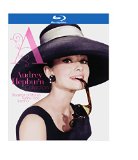| Reviews & Columns |
|
Reviews DVD TV on DVD Blu-ray 4K UHD International DVDs In Theaters Reviews by Studio Video Games Features Collector Series DVDs Easter Egg Database Interviews DVD Talk Radio Feature Articles Columns Anime Talk DVD Savant Horror DVDs The M.O.D. Squad Art House HD Talk Silent DVD
|
DVD Talk Forum |
|
|
| Resources |
|
DVD Price Search Customer Service #'s RCE Info Links |
|
Columns
|
|
|
Audrey Hepburn Collection
THE MOVIE:
Please Note: The stills used here are taken from previous DVD releases and not the Blu-rays under review.
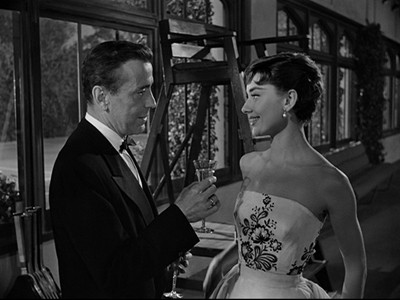
Three of Audrey Hepburn's most beloved films are brought together here under one cover, compiling previously released Blu-ray editions in one sleek package. Though the bundling doesn't necessarily have a strict theme, the set will satisfy viewers who enjoy the actress' penchant for fairy tale romances. All three movies are a Cinderella story, after a fashion, with the actress playing a more mature and sometimes cynical character in each subsequent release.
Sabrina (1954): Audrey Hepburn's second film was the first of hers I saw, though if I recall I watched Sabrina for Humphrey Bogart, whom had become a bit of an obsession by then. I was also starting to learn a little something about director Billy Wilder through a blooming interest in film noir, so it was an unexpected twist in my movie-going plot that these two gentlemen would be upstaged by the gamine up in the tree of this romantic comedy.
Sabrina (Hepburn) is the chauffeur's daughter, a gawky teen who hides in the bushes spying on David Larrabee (William Holden), the youngest and the wildest son of the rich Larrabee family. By contrast, David's older brother, Linus (Bogart), is all stuffed shirts and responsibility. He runs the family company and is more likely to race through numbers and statistics than he is to race the roadster that David is so fond of. Ironically, it's only Linus that notices Sabrina, finding her in the throes of a dramatic suicide over David's cluelessness. Sure, Linus doesn't realize that this silly kid is being serious, but at least he knows her name.
All of this takes place on the eve of Sabrina's departure for Paris, where she will spend two years at a cooking school learning all about soufflés while also learning all the ways of the world that a girl can only acquire in France. She returns to Long Island a sophisticated seductress, ready to claim David as her own. The one wrinkle: Linus has promised David to the daughter of a sugar cane magnate so the Larrabees can get their hands on all the sugar they need for a new plastic compound they are pioneering. Seeing the thrice-married David about to go off message yet again, Linus runs interference, pretending to entertain his baby brother's fickle yearnings while keeping Sabrina occupied. Of course, no numbers or charts can prepare him for Cupid's arrow, and a legitimate love affair blooms in the unlikeliest of places.
Bogart is at his hound-dog best in this picture. Put the man in a tailored suit and take him out of the rough-and-tumble urban and wilderness environments he is better known for, and he actually cuts quite a dashing figure as an aging Prince Charming. Sure, there is a disparity in the years between him and Audrey Hepburn, but it doesn't seem nearly as pronounced as the age gap between her and some of her other leading men. (Wilder would couple her with Gary Cooper in Love in the Afternoon three years later, and it's never quite right; the pair are loving in two entirely different afternoons.) Perhaps it's Bogart's subtle vulnerability that makes it work. His Linus is a lonely man who may know plastics and even how to negotiate social mores as if they were boardroom gambits, but who has ignored his heart as a result. Just as much as Sabrina needs to be rescued from that cad David, Linus needs someone to rescue him from himself. If there is a bit of a fatherly air to his schooling of the ingénue, the ingénue must also play mother to a boy who is still emotionally underdeveloped. Just look at the scene where Linus tries to dress up in his old college sweater: it's like he's swapped places with Sabrina, trying to look young much in the same way she's trying to appear grown up.
Audrey Hepburn is as delightful as can be in the film. To her acting credit, she is almost capable of entirely conquering her own natural glamour to make the teenaged Sabrina appear gawky and naïve. This also allows her to pull off the character's return from Paris, where she must first look like a little girl playing dress up only to reveal she truly is sophisticated in spite of herself. As romances go, one couldn't ask for a smarter director than Billy Wilder, who realizes that when falling in love, the reactions we show to one another aren't nearly as telling as the ones we think no one sees. When the David-Sabrina-Linus triangle begins, we can chart the various emotional upheavals on the dance floor by the way a character's face changes amidst the turn of a slow dance. Thus, an unsuspecting Sabrina can enter a spin out of love and come around to face us again in love.
As with most Billy Wilder movies, Sabrina moves at a brisk pace, teasing the viewer along in ways that are never obvious or manipulative, even when we should be able to see the romantic outcome a mile off. Wilder co-wrote the screenplay with Ernest Lehman and Samuel Taylor, who originally wrote Sabrina as a stageplay, and he knows where all the pieces go. The director has an inherent storytelling instinct for when the narrative can be diverted into a humorous aside and when it needs to get down to serious business. At its core, Sabrina is a Cinderella story, but the fun twist is that the husband she's going to meet at the ball is not the one she expects, and as the audience, we get to go along for the ride as Sabrina figures it all out.
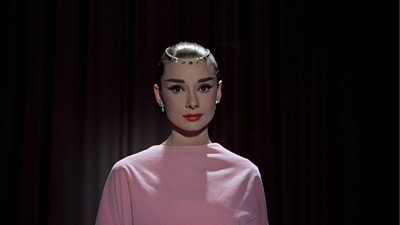
Funny Face (1956): Of the two musicals Audrey Hepburn made, it seems that My Fair Lady gets the most attention, but I personally prefer the far more carefree Funny Face to that stodgy old ball of corn. Though both are ostensibly the same kind of transformative story that Ms. Hepburn's fame and reputation are built on, she was better suited to the light-hearted nature of this 1956 vehicle. Her character is more quirky than pitiable, and Paris fits her better than London. She was, after all, the ultimate Givenchy girl, and the fabulous designer dresses the actress here, teaming with Edith Head to give Funny Face one of cinema's most delectable wardrobes.
Directed by the always impressive Stanley Donen, featuring songs by the Gershwins, and borrowing from the life story of Richard Avedon (who also did the photo manipulations in the movie), Funny Face has all the right ingredients as a musical vehicle for its two stars. Fred Astaire plays the Avedon stand-in, Dick Avery. Working alongside his hard-charging editor, the wonderful Kay Thompson, Avery hatches a plan to create a new campaign for Quality Magazine, one that takes an average, bookish girl and makes her a fashion plate. They find Jo Stockton (Hepburn) in a musty bookshop in Greenwich Village, and despite her strict philosophical principles, she takes their gig as a means to an end. The photo shoot is going to take place in Paris, and once she is in Paris, she can meet her personal guru, Professor Emile Flostre (Michel Auclaire), the father of "Emphaticalism," a philosophy that essentially boils down to "put yourself in my place."
Once in Paris, the supposed ugly duckling turns into a gorgeous swan (or, as it's described in the film, the caterpillar's cocoon did not birth a butterfly, but a bird of paradise), and the black-clad philosopher becomes a stunning model. She is charmed by the romance of the city and by Avery. Crossed wires, though, lead to the usual romantic comedy complications, and a mad dash must be made to put them back together once they are torn apart.
Sure, Funny Face possesses a bizarre anti-intellectualism in the way beauty is given greater value than brains, but that's part of the silly fantasy. There's a reason Kierkegaard has never been the subject of a musical, these things are supposed to be light and airy. Besides, it's pretty easy to see Funny Face for what it is when Astaire is such an old fuddy duddy. The portrayal of the bohemian café where dark personages gather to cry over tragic songs and question the meaning of existence is a little like how your grandfather probably talks about rap music. If you can't laugh at Fred Astaire impersonating a beatnik, then maybe you're as comically dour as the movie would have us believe beatniks of your kind are. Plus, the same setting provides us with the iconic Audrey dance sequence, parodying Martha Graham, that the Gap so shamelessly appropriated for their vile ad campaign a few years ago.
And those are only a sampling of the pleasures you'll find in Funny Face. There is the great music, the gorgeous clothes, and the truly inventive visual sequences Donen concocts for the magazine layouts at the beginning of the movie. In fact, for as much fun as Paris is, from a filmmaking standpoint, Funny Face is at its best in New York. The "Think Pink" number is a marvel of editing and design, and the outer office of Kay Thompson's executive suite is a beautiful concoction of minimalism and color.
And that wedding dress! I hate weddings, but even I love that dress.
So, yeah, the appeal of Funny Face is that it's a bit hokey. The joy of the movie, and its fundamental message to Jo, is that sometimes simplicity is okay. Sometimes we want to partake of something just because it looks nice or it makes us feel good. The fun and the predictability of this kind of exaggerated romance is that it's fun and predictable. What good would it be if it weren't?
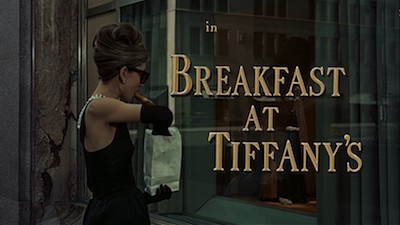
Breakfast at Tiffany's (1961): I have lost track of how many times I have seen Breakfast at Tiffany's, but I can tell you in how many different formats I have seen it. Six. Seven if you count the two different versions on DVD. I've seen it on television broadcast, on VHS, as a 35mm print in a theater, on DVD, as a digital print in the theater, and now Blu-Ray. I know I have easily bested ten viewings, maybe even fifteen. It's a movie I love, it's a movie that's important to me.
Not even I knew what a profound effect it has had on me until I saw the digital restoration projected at the Roseway in Portland, Oregon, back in 2011. Part of it was the experience. The previous theatrical viewing had been a lively Sunday morning screening at a cinema in New York that showed the film every week. (That was 1997 or thereabouts. I wonder if this is still occurring?) This time around, the theater was dark, the audience was smaller; also, the beat-up old print had been swapped for the stunning high-definition restoration. It was revelatory. If you'll indulge the clichés, even though the movie is now more than fifty years old, it was like seeing it for the first time. I didn't know it could look like that!
In that sitting, Breakfast at Tiffany's stopped being this background thing I knew by heart and could watch distractedly, it was reinvigorated as an active creation, a vital artistic expression that communicated to me and captured me whole once more. I was moved to tears multiple times, realizing how much the film had shaped me both personally and professionally, how the adaptation of Truman Capote's story had wheedled its way into my philosophy and point of view. It probably has a little to do with age, as well, that I was better able to grasp some of the subtleties of the story and the performances. For all the flash of Audrey Hepburn's iconic portrayal of Holly Golightly, there is a real vulnerability to the character that rarely gets mentioned; likewise, Paul Varjak is an honest romantic, slightly cynical, slightly hypocritical. Both characters have sacrificed pieces of themselves, of their hearts and their dreams, for quick and easy rewards. It's a movie about the compromises we make to get by, be it in romance or work or art or just life in general, and the illusions we build to tell ourselves and others that we haven't sold off any of who we are. The biggest lie of all is to say "I am okay."
For those not in the know, the breakdown of Breakfast at Tiffany's is thus: Holly Golightly (Hepburn) is a model/actress/call girl who moved from Texas to Hollywood and now New York, where she parties and pursues rich men in hope of one day cashing in. At the start of the picture, a handsome author, Paul Varjak (George Peppard), is moving into the apartment upstairs from her. A friendship instantly develops, as does an attraction, though Paul is too poor for Holly's lifeplan. He has been struggling with his second book for years, and he is now a kept man, his rent and his wage paid by a rich married woman (the divine Patricia Neal). Holly inspires him to get back on track, but he can't return the favor, she won't allow him to be his white knight. She chases more rich men, wins some and loses some. She also has a side job making weekly visits to gangster Sally Tomato (Alan Reed) in prison, carrying back coded messages to Sally's "lawyer." Paul tells her straight out that this will get her in trouble, and, of course, he's right.
There are many memorable sequences in Breakfast at Tiffany's. An extended party sequence, filmed over a night as the actors got drunk and improvised new comedic business, is amazing in how its loose construction tracks the escalation and downturn of a real soiree. The string of gags is hilarious, and the idea works so well, director Blake Edwards would stretch the concept out to a feature-length movie seven years later (The Party, starring Peter Sellers). Another unforgettable montage comes later in the movie when, to celebrate Paul's having sold a story, the pair spend an afternoon challenging each other to do things they've never done before. They visit the library, shoplift Halloween masks, and even shop at Tiffany's.
It's a romantic chapter in the story, endearing these troubled characters to the audience and each other. Breakfast at Tiffany's is most easily classified as a romantic comedy, but as Sally Tomato notes when examining Holly's financial diary, it's really a tragedy, a story to break your heart. Blake Edwards and screenwriter George Axelrod (The Manchurian Candidate) had to soften some of the more controversial edges of Truman Capote's novella to meet censorship standards of the early 1960s--Holly's escort work is only euphemistically referred to as getting $50 to go to the powder room, and she's shown largely dodging the sex the men think they are buying--but the darker undertones are still there. Holly's New York circle is populated by rats and super rats. Gangsters and pornographers, models and agents, entrepreneurs and diplomats all rub elbows on the party circuit, all angling for their own selfish motives. In some regards, Holly's way of making a living--and let's be honest, Paul's too; his ethical pronouncements only paper over his guilt at being a gigolo (though, in the book, he was gay)--is more honest. She at least states what she wants outright, and even does what she does for the benefit of another. Her brother Fred is a phantom that hangs over the picture, the last symbol of her early innocence, a dumb giant who has no one else in the world but his distant sister.
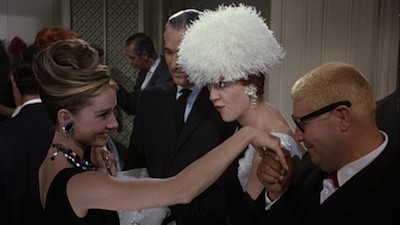
Breakfast at Tiffany's is not a perfect film. It is my favorite Audrey Hepburn movie, but it's not the best. The plot can be a bit meandering, Peppard is a little stiff, and the tonal shifts from slapstick to drama and romance can be jarring. Easily the film's biggest sin is casting Mickey Rooney as Mr. Yunioshi, the Japanese photographer that lives in the building with Holly and Paul. It's an unfortunate racist caricature, one that I doubt could have even been saved by hiring an actual Japanese actor to fill the role. It's also just not a good performance. Rooney isn't funny. The writing may stink, but he stinks worse. It's easy to move on from, though, once you know it's there. The overall charm and color of the film win out over whatever other hiccups occur. The beautiful Henry Mancini score, with "Moon River" as its central theme, hypnotically buffs out the blemishes.
The film's final scenes are perhaps its most moving and iconic, and for my money feature one of the most honest dialogues about the nature and semantics of love in any movie. Sure, there is some familiar Hollywood magic sprinkled over it, the resolution is aimed at the pleasure center of audience expectations, but the content of the exchange between Holly and Paul has some brutal subtext. Paul is a bit of a jackass about everything, but Holly has put him through the ringer, and it's refreshing to see two adults, no matter how idealized, hash it out in this manner and ultimately accept their mutual imperfections rather than think there is some ridiculous way to "fix" everything. There is no great epiphany so much as there is a capitulation to emotion over equivocation and rationalizing. Also, a kiss in the rain! With a cat! I dare you to be cynical about it, you heartless cad. I dare you.
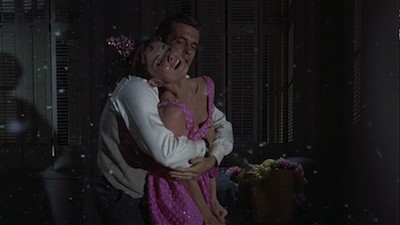
THE BLU-RAY
Video/Sound:
This three-disc set is released in a slim, economical package, with all three movies fitting in a multi-tray plastic case only slightly thicker than your average Blu-ray housing. There is also a cardboard slipcover to go with it.
Picture and sound match the earlier individual Blu-ray releases for these movies, with the Breakfast at Tiffany's getting the most notable upgrade, having been fully restored in 4K for a theatrical tour. Colors and detail both amaze, and it is a smidgen better than Funny Face, which in itself is fine; however, the rendering on both can sometimes make the characters appear a little plastic. The images are otherwise clean and free of blemish, the resolution is just a little sharp at times, with occasional touches of DNR.
No such problems exists for the black-and-white Sabrina, which has been cleaned up nicely and sports impressive detail and good contrast between dark and light.
Audio on all three releases have been spruced up for newer sound systems, with Funny Face and Breakfast at Tiffany's going all the way with DTS-HD Master Audio mixed in 5.1. Sabrina's main audio track is 2.0, and there is also an alternate stereo version on Funny Face. The new mixes sound very good, without ever being to overbearing, keeping the simplicity of the original sound design while separating the parts for a little added depth.
Alternate language options on all discs include French and English. Breakfast at Tiffany's also has a restored mono track.
Extras:
The special features have been ported over from various different versions throughout the years, making each Blu-ray as close to the "definitive" versions as you're likely to get.
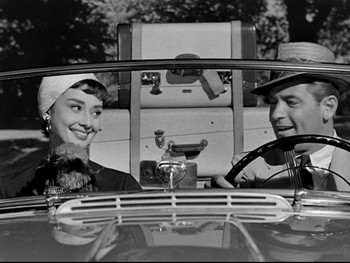
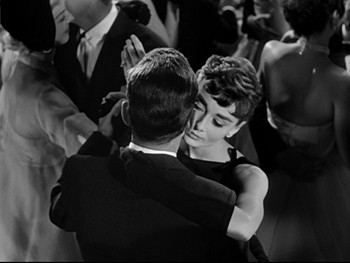
For Sabrina, we are essentially getting the contents of the second disc from 2008's Centennial Collection release.
* "Audrey Hepburn: Fashion Icon", a 17-minute, 30-second rundown of the actress' most famous looks with fashion designers like Isaac Mizrahi, Cynthia Rowley, and Eduardo Lucero and fashion historian Eddie Bledsoe sharing their opinions about what made Hepburn special. This covers more of Hepburn's Paramount movies than just Sabrina, and there is some focus on designers Edith Head and Hubert de Givenchy. Lucero and designer Trina Turk also take us through their Audrey-inspired fashion lines and talk about how to achieve her look.
*"Sabrina's World" (11:25) looks at the setting of Sabrina, including real places on the Gold Coast of Long Island.
*"Supporting Sabrina" (16:32) pays tribute to the famous Paramount character actors who rounded out the cast of the movie, including Sabrina's father as played by John Williams; Ellen Corby, who was Linus' secretary; the maid Jenny, Nancy Kulp; Marcel Dalio as the Parisian count who schools Sabrina; Walter Hampden, a.k.a. Mr. Larrabee; Francis X. Bushman, David's future father-in-law; and Martha Hyer, David's fiancée. This includes clips for other films the actors appeared in.
*"William Holden: The Paramount Years" (24:40) is an examination of Holden's career, beginning as a Paramount contract player (shared at the time with Columbia), through the war years, and eventually becoming a huge star after success working with Billy Wilder for the first time in Sunset Boulevard. Actresses Pat Crowley and Stefanie Powers, actors Gil Stratton and Gene Reynolds, author Bob Thomas, and others talk about the man amidst photos and clips from his many movies. The piece touches on Sabrina, following with Holden's free agency in the 1960s and his work in preserving animals from extinction in Africa, and it ends with his early '80s work for Paramount in Blake Edwards' S.O.B.. He died shortly after.
*"Behind the Gates: Camera" (5:07) takes us away from Sabrina to show us the development of motion picture camera technology at Paramount.
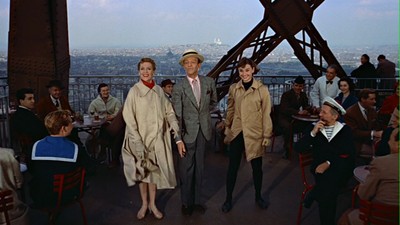
As the Funny Face BD also maintains the Centennial Collection model, the extras here follow a similar tack:
* "The Fashion Designer and His Muse" looks at the relationship between Audrey and Hubert de Givenchy, while "Parisian Dreams" talks about the locations used in Funny Face and explains more about what Richard Avedon contributed to the production.
* "Fashion Photographers Exposed" (17 minutes, 52 seconds), a day in the life of a fashion crew taking photos inspired by Audrey Hepburn in Funny Face. In it, the photographers and designers talk about their work, Richard Avedon, and how fashion was portrayed in this film. It's not particularly insightful, and the photo session, I'm sorry to say, is fairly basic.
* "This is VistaVision" (24:37) -- historians and camera techs talk about the creation of the massive VistaVision process, which was the start of the 1.85:1 aspect ratio and done as a Paramount's attempt to combat the growing popularity of television. Clips from the Paramount movies from over the decade or so the process was used are shown (the first ever was White Christmas), and the film also looks at how Richard Edlund revived the process to use for multi-plane special effects while shooting Star Wars.
& "Kay Thompson: Think Pink" (26:30) -- The actress who played the magazine editor in Funny Face, as it turns out, was a remarkable woman. As a songwriter, she helped create the MGM sound; as an author, she dreamed up the beloved character Eloise; and as an older woman, she was an influential actress and fashion icon, spending her later years living with her goddaughter, Liza Minnelli. Interviewed from the documentary are biographer Sam Irvin; Jim Caruso, Liza's collaborator on a tribute show about Kay (there are also clips of Liza talking about her, and rare footage and photos of Thompson); Dick Williams, one of the Williams Brothers, who spent many years as a nightclub act with Thompson; Hilary Knight, the artist on the Eloise books; Matt Crowley, who finished the last Eloise book with Knight; and Ruta Lee, who played Thompson's assistant in Funny Face.
* Theatrical Trailer
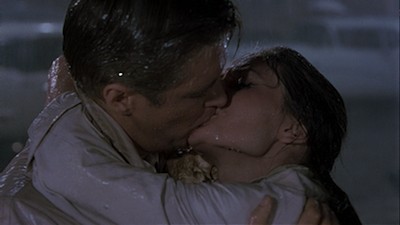
Finally, Breakfast at Tiffany's:
* Audio Commentary by Richard Shepherd: This a terrible track. I first watched it on the 2006 "Anniversary Edition" DVD and it has haunted me ever since. Completely void of insight or interesting anecdotes and full of pregnant pauses. Just boring. Though, if you ever wished someone would apologize for Mickey Rooney, Shepherd has your back. He does it every time Yunioshi is on screen. Okay, we get it!!! He is also covered in "Mr. Yunioshi: An Asian Perspective" (17 minutes): A smart featurette using the controversial character as a way to spin off to talk about race and the depiction of Asians in Hollywood.
* "A Golightly Gathering" (20 mins.): A set of interviews specifically about the party scene.
* "Henry Mancini: More than Music" (21 mins.): An exploration of the composer and his life using interviews with friends and colleagues.
* Theatrical Trailer
* "The Making of a Classic" (15 mins.): A basic retrospective.
* "It's So Audrey! A Style Icon" (8 mins.): Examining the appeal of Ms Hepburn.
* "Behind the Gates: The Tour" (4 mins.): A visual tour of the Paramount studios.
* "Brilliance in a Blue Box" (5 mins.)/"Audrey's Letter to Tiffany" (2 mins.): A little nod to Tiffany's and their jewelry, including a tribute written by Hepburn in 1987.
* Galleries: Movie stills, production pieces, and publicity materials.
FINAL THOUGHTS:
DVD Talk Collector Series. Though, sure, The Audrey Hepburn Collection is just a gathering of previously released discs and breaks no new ground in terms of technology, the three films it puts together are essential to any collection. Sabrina, Funny Face, and Breakfast at Tiffany's are among the screen legend's finest, and serve as an excellent starter course or a regular refresher to revisit regularly and let Ms. Hepburn work her charm.
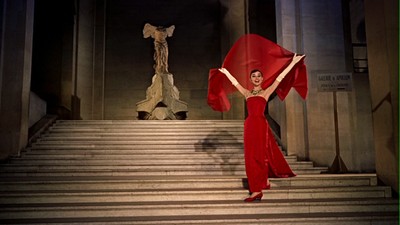
Jamie S. Rich is a novelist and comic book writer. He is best known for his collaborations with Joelle Jones, including the hardboiled crime comic book You Have Killed Me, the challenging romance 12 Reasons Why I Love Her, and the 2007 prose novel Have You Seen the Horizon Lately?, for which Jones did the cover. All three were published by Oni Press. His most recent projects include the futuristic romance A Boy and a Girl with Natalie Nourigat; Archer Coe and the Thousand Natural Shocks, a loopy crime tale drawn by Dan Christensen; and the horror miniseries Madame Frankenstein, a collaboration with Megan Levens. Follow Rich's blog at Confessions123.com.
|
| Popular Reviews |
| Sponsored Links |
|
|
| Sponsored Links |
|
|
| Release List | Reviews | Shop | Newsletter | Forum | DVD Giveaways | Blu-Ray | Advertise |
|
Copyright 2024 DVDTalk.com All Rights Reserved. Legal Info, Privacy Policy, Terms of Use,
Manage Preferences,
Your Privacy Choices | |||||||









